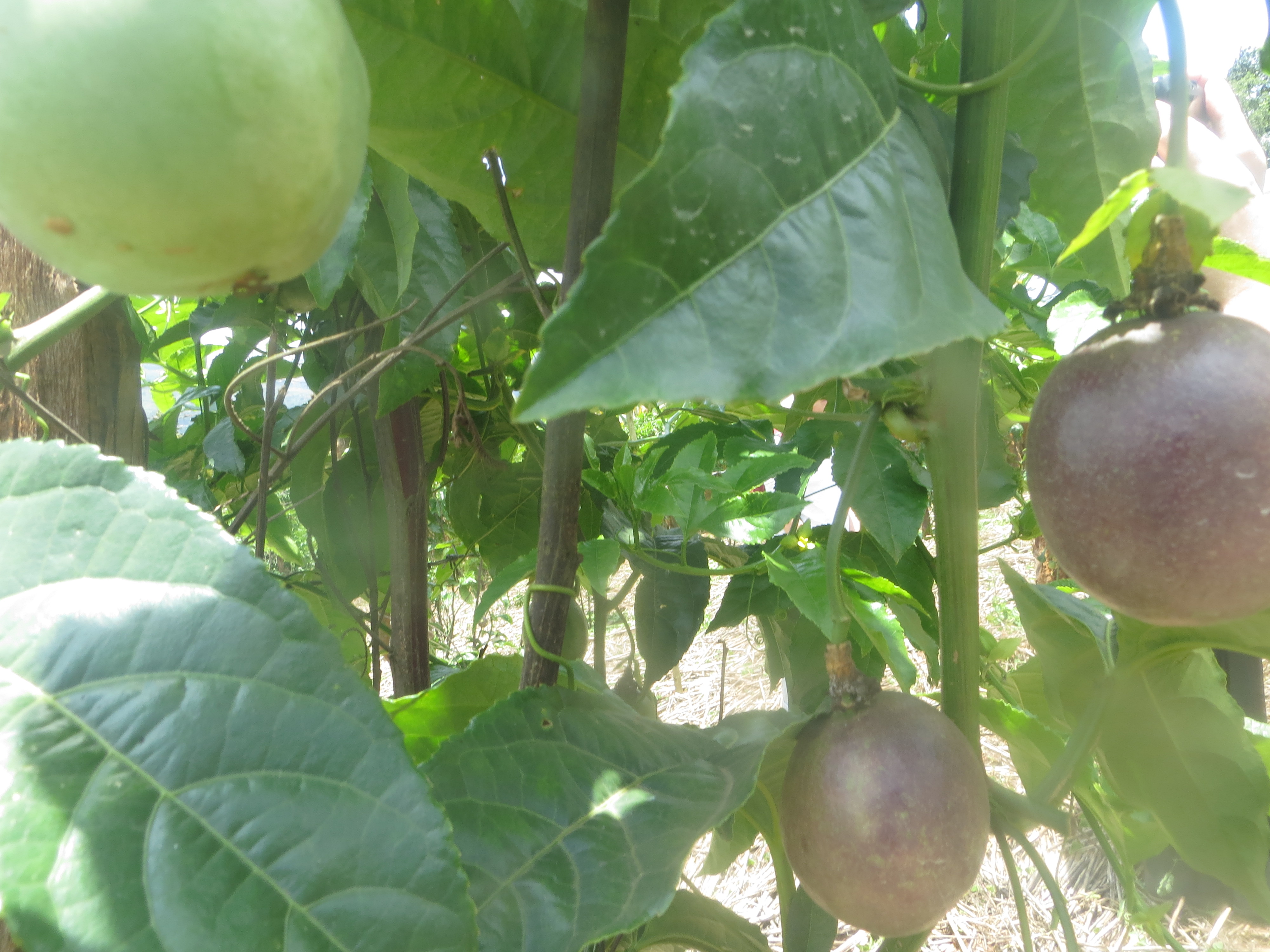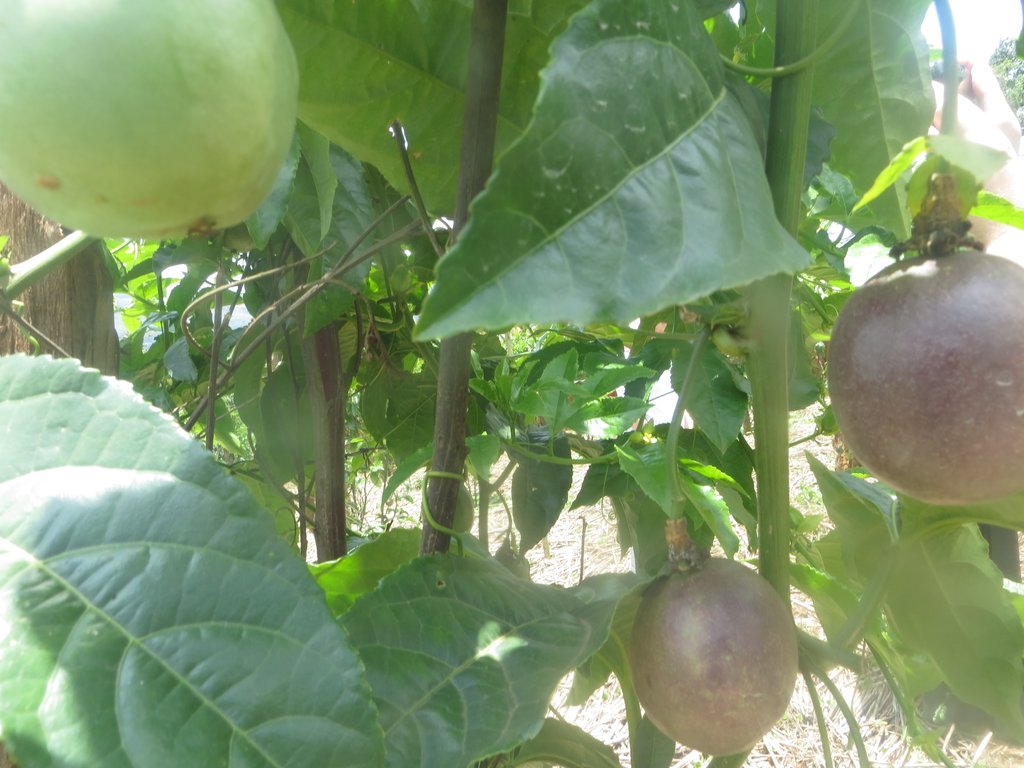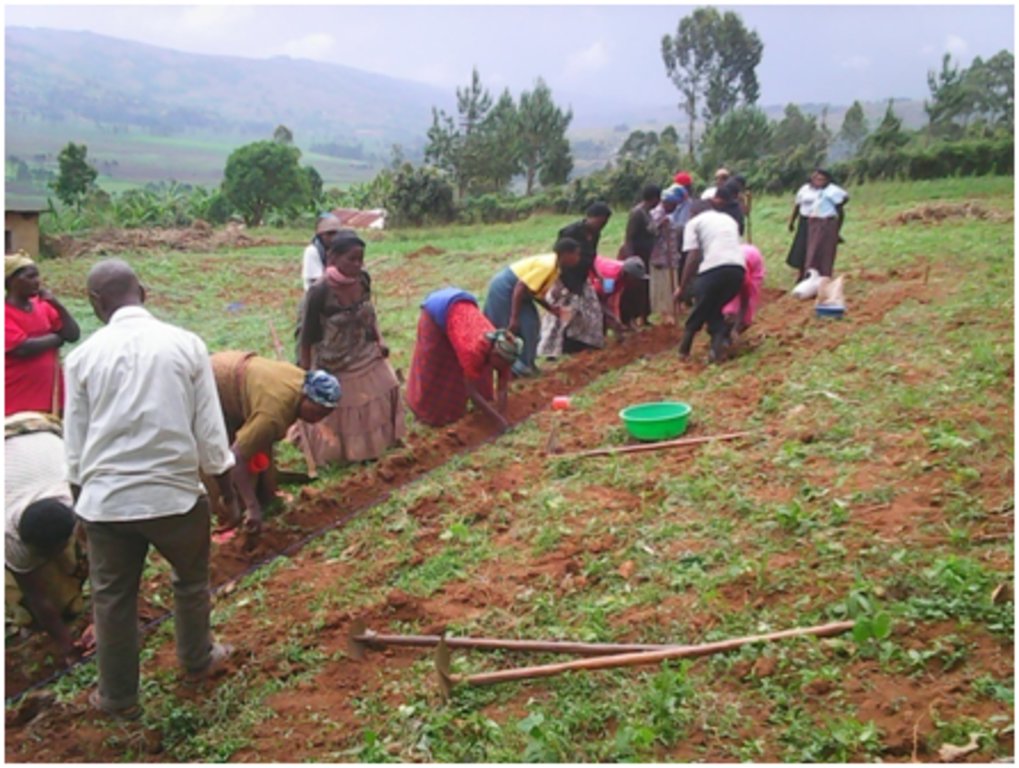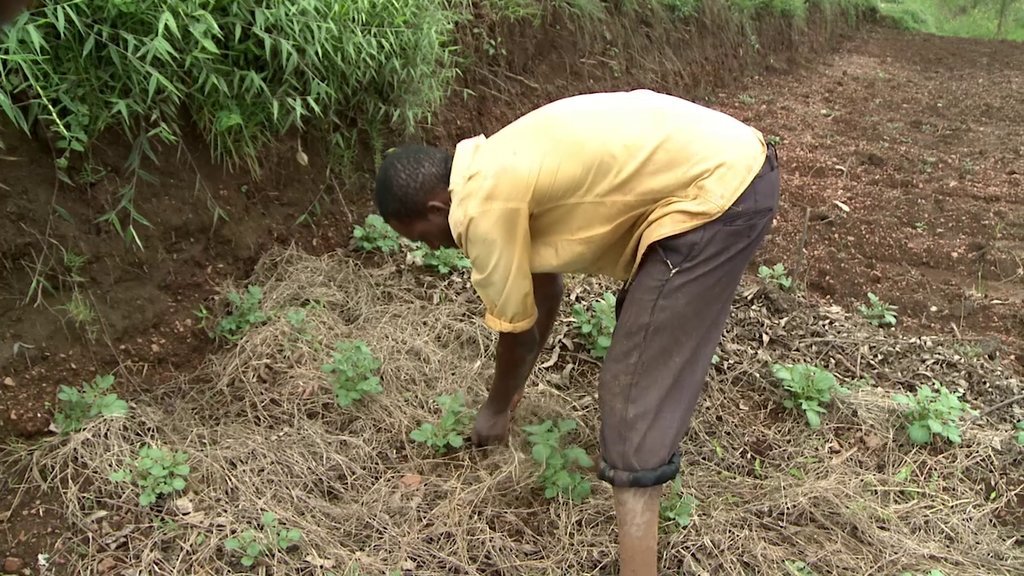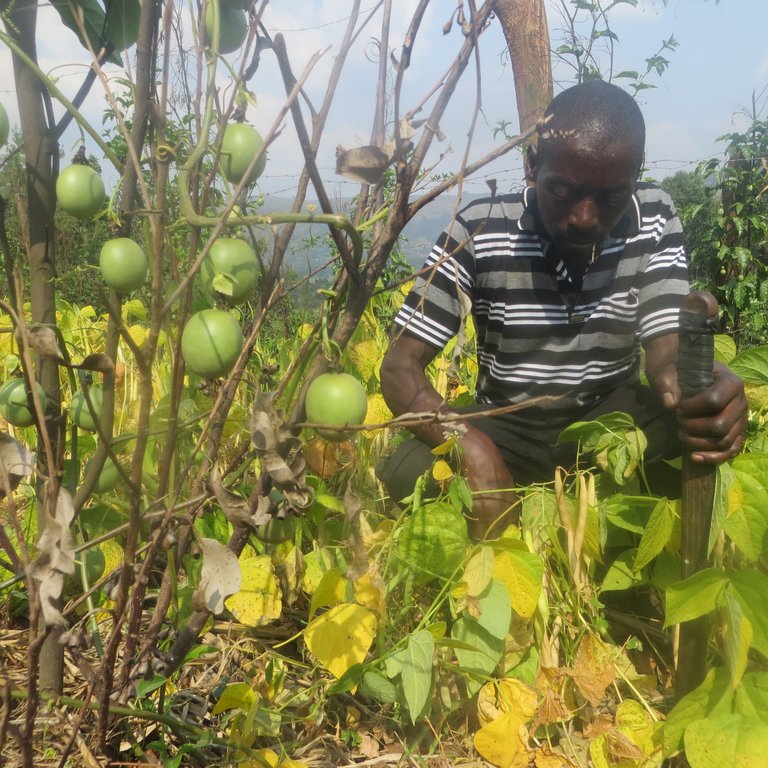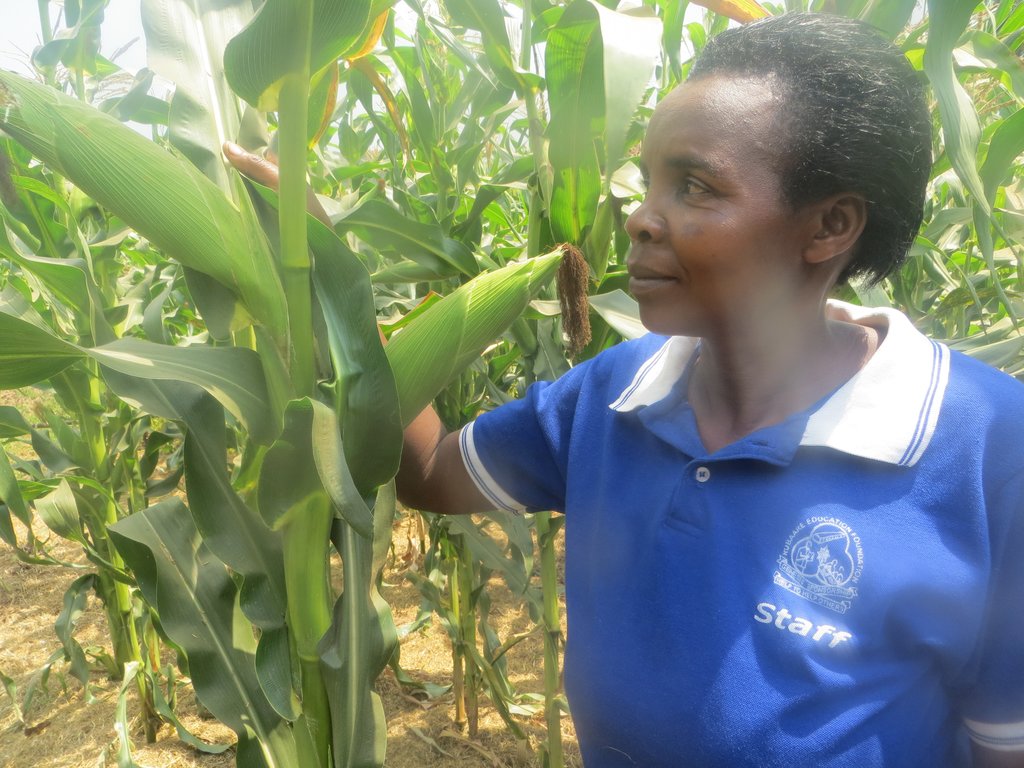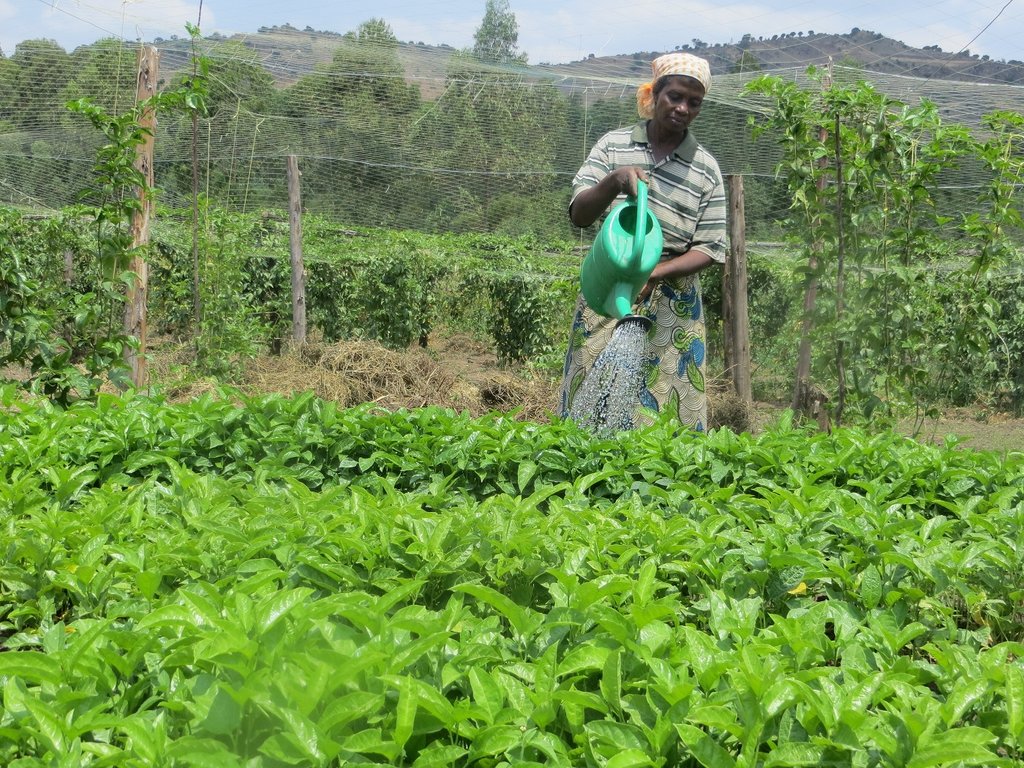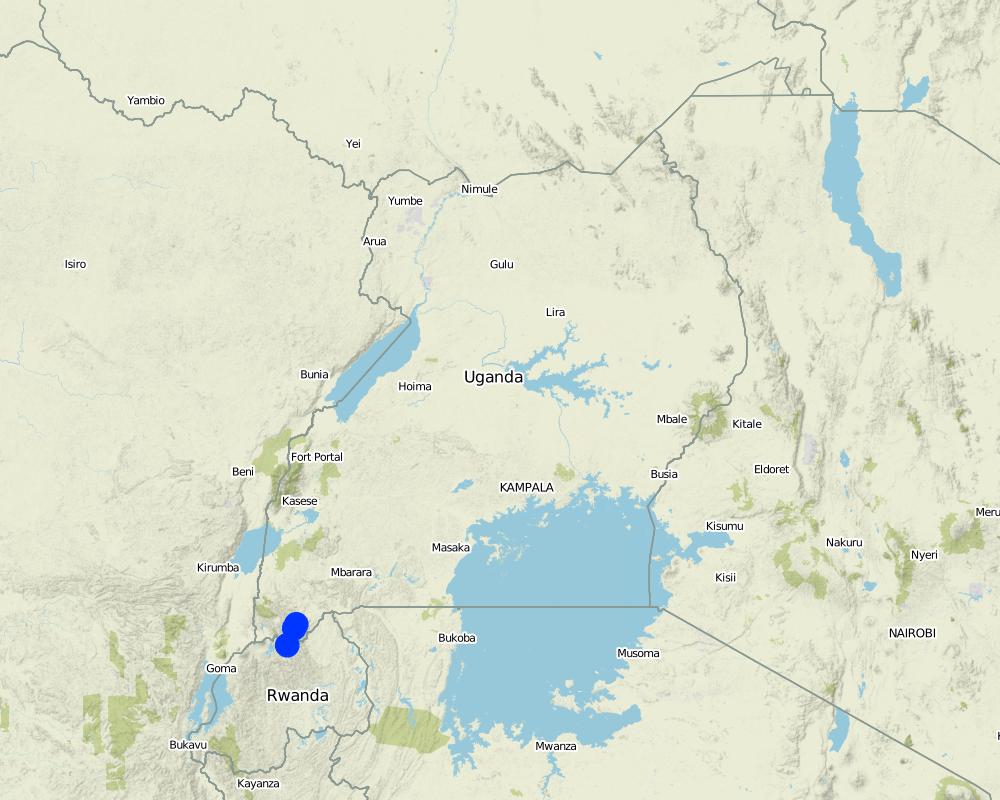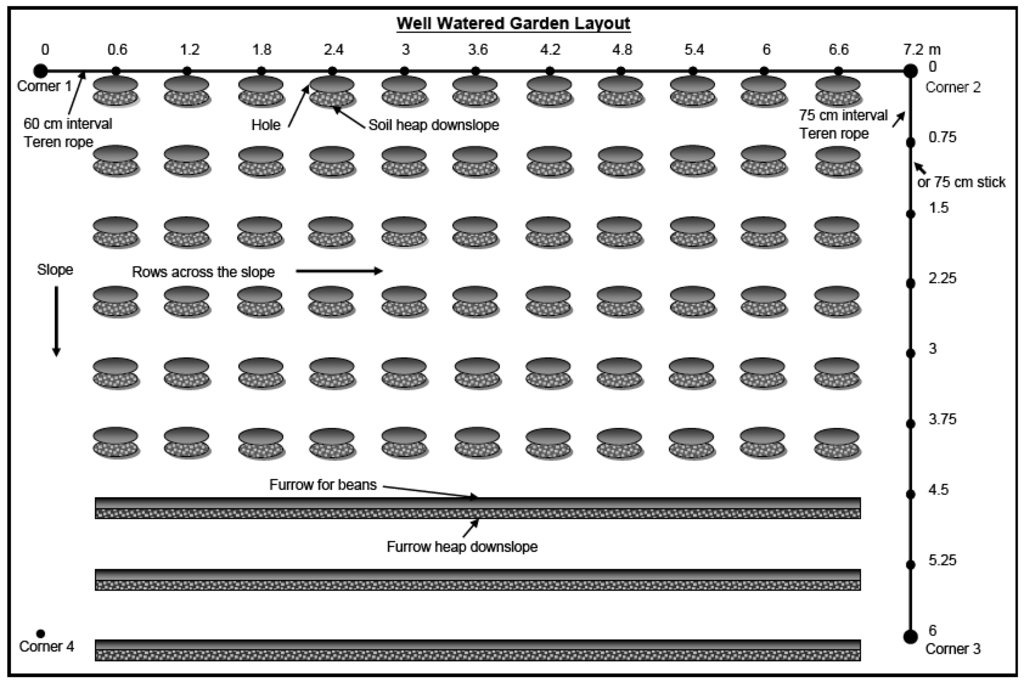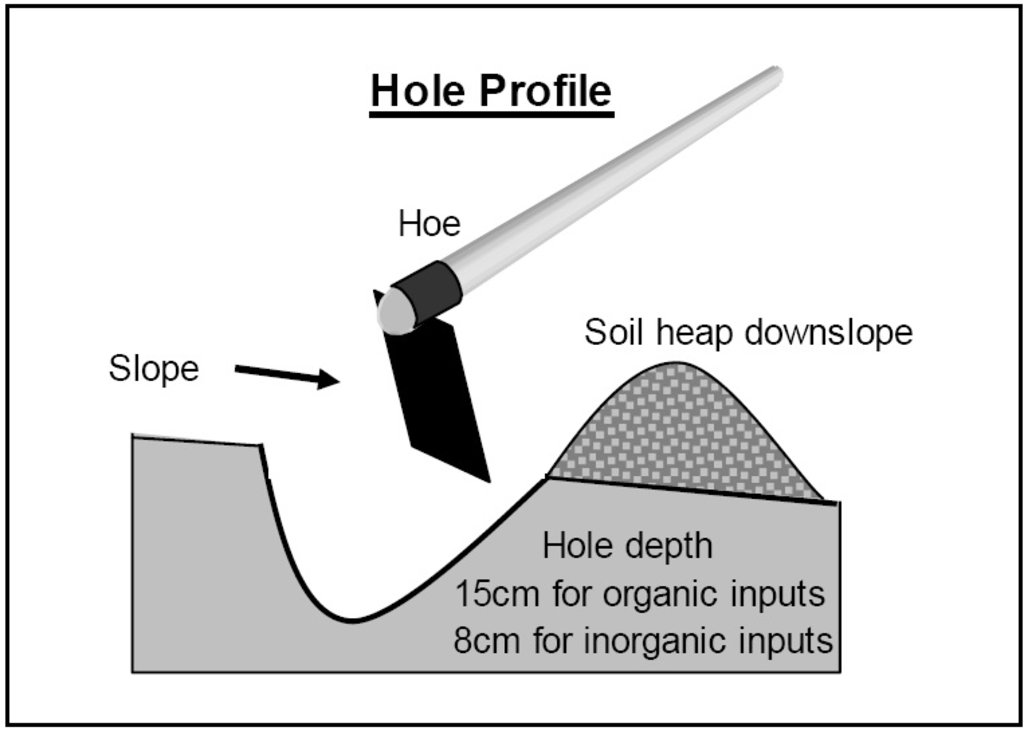Farming God's Way [Uganda]
- Creation:
- Update:
- Compiler: Philip Tibenderana
- Editor: Mirjam Nufer
- Reviewers: Hanspeter Liniger, Nicole Harari, Alexandra Gavilano
Empinga ya Ruhanga
technologies_719 - Uganda
View sections
Expand all Collapse all1. General information
1.2 Contact details of resource persons and institutions involved in the assessment and documentation of the Technology
Key resource person(s)
SLM specialist:
Name of project which facilitated the documentation/ evaluation of the Technology (if relevant)
Book project: where people and their land are safer - A Compendium of Good Practices in Disaster Risk Reduction (DRR) (where people and their land are safer)Name of the institution(s) which facilitated the documentation/ evaluation of the Technology (if relevant)
Tear Fund Switzerland (Tear Fund Switzerland) - Switzerland1.3 Conditions regarding the use of data documented through WOCAT
When were the data compiled (in the field)?
07/09/2016
The compiler and key resource person(s) accept the conditions regarding the use of data documented through WOCAT:
Ja
1.4 Declaration on sustainability of the described Technology
Is the Technology described here problematic with regard to land degradation, so that it cannot be declared a sustainable land management technology?
Nee
Comments:
So far, where this technology has been applied, soil erosion has been reduced and crop yields have increased
1.5 Reference to Questionnaire(s) on SLM Approaches
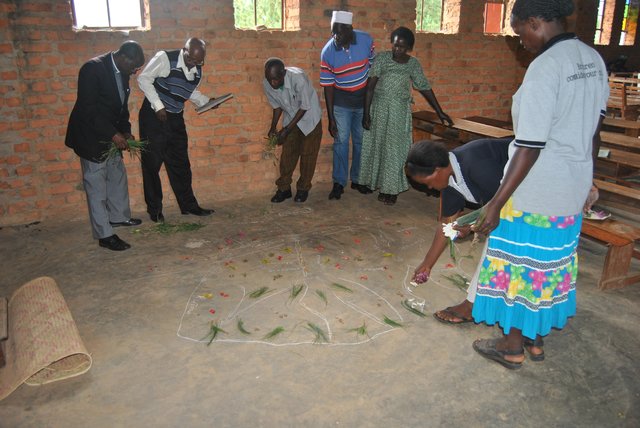
Catchment Based Integrated Water Resources Management [Uganda]
Catchment based integrated water resources management is a process which promotes the coordinated development and management of water, land and related resources in order to maximise economic and social welfare in an equitable manner without compromising the sustainability of vital eco systems
- Compiler: Philip Tibenderana
2. Description of the SLM Technology
2.1 Short description of the Technology
Definition of the Technology:
Farming Gods Way is a method of farming which aims to preserve soil structure through minimum tillage, mulching with grass or plant stalks and use of organic manure for improved crop yields.
2.2 Detailed description of the Technology
Description:
The technology is applied in already existing farmlands, which are individually owned and land users are practicing conventional/traditional farming methods. An average farm size is less than half an acre.
It is built on the fact that when God created the first garden, it was a highly productive rainforest which was in need of nothing. The forest was capable of succeeding even in drought years and never slowed or lost its productivity. The trees never lost their leaves or wilt. They keep on producing flowers, fruits and seeds and are able to carry vast numbers and diversity of animal species. God put mechanisms in place which would allow the fauna, flora and soil to co-exist, with high levels of productivity, no environmental degradation, little or no erosion and a high buffering ability to withstand all the negative parameters of the harsh climate. Therefore, this technology helps to maintain soil structure and texture increasing its ability for water retention and soil fertility, thus increasing crop yields.
The major activities needed to establish the technology include; awareness creation and training land users on the technology, setting up demonstration gardens, identification of contact farmers, supporting them to establish demonstration gardens in the community and follow up support to the implementing farmers.
What the land users dislike about this technology is that it involves a lot of measurements and record keeping, which they are not used to, the mulching material is not readily available and the mulch harbors rodents.
2.3 Photos of the Technology
2.5 Country/ region/ locations where the Technology has been applied and which are covered by this assessment
Country:
Uganda
Region/ State/ Province:
South Western Region
Further specification of location:
Rubaya, Rwamucucu and Kyanamira Sub Counties, Kabale District
Map
×2.6 Date of implementation
Indicate year of implementation:
2015
2.7 Introduction of the Technology
Specify how the Technology was introduced:
- through projects/ external interventions
Comments (type of project, etc.):
The technology was introduced under the Integrated Water Resources Management Project to support farmers to mazimise land productivity
3. Classification of the SLM Technology
3.1 Main purpose(s) of the Technology
- improve production
- reduce, prevent, restore land degradation
- conserve ecosystem
- reduce risk of disasters
- adapt to climate change/ extremes and its impacts
- create beneficial economic impact
- create beneficial social impact
3.2 Current land use type(s) where the Technology is applied

Cropland
- Annual cropping
- Perennial (non-woody) cropping
Main crops (cash and food crops):
Potatoes, beans, maize, sorghum, cabbages, tobacco, peas, wheat, barley

Mixed (crops/ grazing/ trees), incl. agroforestry
- Agroforestry
Main products/ services:
Trees, poles, fodder, firewood
3.3 Further information about land use
Water supply for the land on which the Technology is applied:
- rainfed
Number of growing seasons per year:
- 2
Specify:
September to January and March to June
3.4 SLM group to which the Technology belongs
- rotational systems (crop rotation, fallows, shifting cultivation)
- minimal soil disturbance
- integrated soil fertility management
3.5 Spread of the Technology
Specify the spread of the Technology:
- evenly spread over an area
Comments:
This technology has been demonstrated in specific villages so that land users can learn and implement it on their individual plots of land
3.6 SLM measures comprising the Technology

agronomic measures
- A2: Organic matter/ soil fertility
- A3: Soil surface treatment

management measures
- M4: Major change in timing of activities
3.7 Main types of land degradation addressed by the Technology

chemical soil deterioration
- Cn: fertility decline and reduced organic matter content (not caused by erosion)

physical soil deterioration
- Pc: compaction

biological degradation
- Bc: reduction of vegetation cover
- Bf: detrimental effects of fires
- Bl: loss of soil life
3.8 Prevention, reduction, or restoration of land degradation
Specify the goal of the Technology with regard to land degradation:
- reduce land degradation
4. Technical specifications, implementation activities, inputs, and costs
4.1 Technical drawing of the Technology
4.2 Technical specifications/ explanations of technical drawing
This drawing shows the layout of a well-watered garden. After the land is shaved (removal of top vegetative cover), it is measured out following specifications using a teren rope (a non-stretch, hardy, measuring rope used to ensure that crops are planted in straight lines). The planting stations are dug (holes and furrows) and required inputs like ash and fertiliser are added and finally seeds planted. Hole and furrow depths vary with the type of crop to plant but are usually 150mm deep. The spaces between the rows is covered with mulch.
4.3 General information regarding the calculation of inputs and costs
Specify how costs and inputs were calculated:
- per Technology area
Indicate size and area unit:
Acre
Specify currency used for cost calculations:
- US Dollars
Indicate exchange rate from USD to local currency (if relevant): 1 USD =:
3300.0
Indicate average wage cost of hired labour per day:
USD 2.12
4.4 Establishment activities
| Activity | Type of measure | Timing | |
|---|---|---|---|
| 1. | Making of compost manure | Agronomic | After harvest of crops |
| 2. | Clearing the land (removing above ground vegetation) | Management | Before onset of rains |
| 3. | Shaving the land (skinning of vegetative cover) | Agronomic | Before the onset of rains |
| 4. | Seed selection | Agronomic | Before the onset of rains |
| 5. | Gathering mulch material | Management | Before the onset of rains |
| 6. | Setting out (measuring, making planting stations, adding ash and manure) | Agronomic | Before the onset of rains |
| 7. | Application of mulch | Agronomic | Before the onset of rains |
| 8. | Planting | Management | Onset of rains |
| 9. | Thinning, staking, gap filling, top dressings | Agronomic | 3 weeks after planting |
| 10. | Spraying herbicides | Agronomic | Weekly |
| 11. | Harvesting and storing | Management | From 90 days onwards |
4.5 Costs and inputs needed for establishment
| Specify input | Unit | Quantity | Costs per Unit | Total costs per input | % of costs borne by land users | |
|---|---|---|---|---|---|---|
| Labour | Making compost, clearing, shaving, seed selection, gathering mulch | person days | 91.0 | 2.12 | 192.92 | 100.0 |
| Labour | Setting out, applying mulch, planting, thinning, staking gap filling, spraying, harvesting and storing | person days | 61.0 | 2.12 | 129.32 | 100.0 |
| Equipment | Tools set (hoe, terrain rope, pliers, measuring tape, spade, garden fork, panga) | acre | 1.0 | 2.952 | 2.95 | |
| Equipment | Spraying pump (1 over 20 acres) | pieces | 0.05 | 27.27 | 1.36 | |
| Equipment | Wheel barrow (1 over 20 acres) | pieces | 0.05 | 36.36 | 1.82 | |
| Equipment | Watering can (1 over 5 acres) | pieces | 0.2 | 3.03 | 0.61 | |
| Plant material | Seed | kg | 30.0 | 1.06 | 31.8 | 100.0 |
| Plant material | Stakes (200 bundles used 2 times) | bundles | 100.0 | 0.76 | 76.0 | 100.0 |
| Plant material | Mulch | trips | 10.0 | 30.3 | 303.0 | 100.0 |
| Fertilizers and biocides | Pesticides | litres | 0.1 | 6.06 | 0.61 | 100.0 |
| Total costs for establishment of the Technology | 740.39 | |||||
If land user bore less than 100% of costs, indicate who covered the remaining costs:
Kigezi Diocese Water and Sanitation Programme
Comments:
Land users can provide labour and seed but they need to be supported with tools, equipment and technical knowledge
4.6 Maintenance/ recurrent activities
| Activity | Type of measure | Timing/ frequency | |
|---|---|---|---|
| 1. | Removing weeds after harvest as land users wait for next planting season | Agronomic | After harvest |
4.7 Costs and inputs needed for maintenance/ recurrent activities (per year)
| Specify input | Unit | Quantity | Costs per Unit | Total costs per input | % of costs borne by land users | |
|---|---|---|---|---|---|---|
| Labour | Removing weeds | days | 1.0 | 2.12 | 2.12 | 100.0 |
| Total costs for maintenance of the Technology | 2.12 | |||||
4.8 Most important factors affecting the costs
Describe the most determinate factors affecting the costs:
The most significant cost in this technology is mulch. In cases where land is very fragmented, it is inaccessible by road and all materials have to be carried to site which increases the costs of labour
5. Natural and human environment
5.1 Climate
Annual rainfall
- < 250 mm
- 251-500 mm
- 501-750 mm
- 751-1,000 mm
- 1,001-1,500 mm
- 1,501-2,000 mm
- 2,001-3,000 mm
- 3,001-4,000 mm
- > 4,000 mm
Specifications/ comments on rainfall:
Bi-modal rainfall pattern with long rainy season from September to December then March to May
Indicate the name of the reference meteorological station considered:
Kabale District Meterological Department
Agro-climatic zone
- sub-humid
5.2 Topography
Slopes on average:
- flat (0-2%)
- gentle (3-5%)
- moderate (6-10%)
- rolling (11-15%)
- hilly (16-30%)
- steep (31-60%)
- very steep (>60%)
Landforms:
- plateau/plains
- ridges
- mountain slopes
- hill slopes
- footslopes
- valley floors
Altitudinal zone:
- 0-100 m a.s.l.
- 101-500 m a.s.l.
- 501-1,000 m a.s.l.
- 1,001-1,500 m a.s.l.
- 1,501-2,000 m a.s.l.
- 2,001-2,500 m a.s.l.
- 2,501-3,000 m a.s.l.
- 3,001-4,000 m a.s.l.
- > 4,000 m a.s.l.
Indicate if the Technology is specifically applied in:
- not relevant
5.3 Soils
Soil depth on average:
- very shallow (0-20 cm)
- shallow (21-50 cm)
- moderately deep (51-80 cm)
- deep (81-120 cm)
- very deep (> 120 cm)
Soil texture (topsoil):
- medium (loamy, silty)
Soil texture (> 20 cm below surface):
- medium (loamy, silty)
Topsoil organic matter:
- medium (1-3%)
5.4 Water availability and quality
Ground water table:
> 50 m
Availability of surface water:
good
Water quality (untreated):
poor drinking water (treatment required)
Is water salinity a problem?
Nee
Is flooding of the area occurring?
Ja
Regularity:
episodically
5.5 Biodiversity
Species diversity:
- medium
Habitat diversity:
- medium
5.6 Characteristics of land users applying the Technology
Sedentary or nomadic:
- Sedentary
Market orientation of production system:
- subsistence (self-supply)
- mixed (subsistence/ commercial
Off-farm income:
- less than 10% of all income
Relative level of wealth:
- poor
Individuals or groups:
- individual/ household
Level of mechanization:
- manual work
Gender:
- women
- men
Age of land users:
- youth
- middle-aged
5.7 Average area of land owned or leased by land users applying the Technology
- < 0.5 ha
- 0.5-1 ha
- 1-2 ha
- 2-5 ha
- 5-15 ha
- 15-50 ha
- 50-100 ha
- 100-500 ha
- 500-1,000 ha
- 1,000-10,000 ha
- > 10,000 ha
Is this considered small-, medium- or large-scale (referring to local context)?
- small-scale
5.8 Land ownership, land use rights, and water use rights
Land ownership:
- individual, not titled
Land use rights:
- individual
Water use rights:
- communal (organized)
5.9 Access to services and infrastructure
health:
- poor
- moderate
- good
education:
- poor
- moderate
- good
technical assistance:
- poor
- moderate
- good
employment (e.g. off-farm):
- poor
- moderate
- good
markets:
- poor
- moderate
- good
energy:
- poor
- moderate
- good
roads and transport:
- poor
- moderate
- good
drinking water and sanitation:
- poor
- moderate
- good
financial services:
- poor
- moderate
- good
6. Impacts and concluding statements
6.1 On-site impacts the Technology has shown
Socio-economic impacts
Production
crop production
Comments/ specify:
Methods used increase soil fertility
crop quality
Comments/ specify:
One of the FGW is ‘to high standards’
risk of production failure
Comments/ specify:
Practicing ‘on time’ reduces this risk
product diversity
Comments/ specify:
FGW promotes crop rotation
production area
Comments/ specify:
Previously unused land can be put to use
land management
Comments/ specify:
Mulching and minimum tillage improve soil structure
Income and costs
expenses on agricultural inputs
Comments/ specify:
Need for epuipment
farm income
Comments/ specify:
More than doubles the traditional income
diversity of income sources
Comments/ specify:
Use of livestock to provide manure
workload
Comments/ specify:
Minimum tillage and with thick mulch, labour on weeding is reduced
Socio-cultural impacts
food security/ self-sufficiency
Comments/ specify:
Increases yields by more than twice the traditional way
cultural opportunities
Comments/ specify:
One of the biblical keys is ‘taking tithe and offering’
SLM/ land degradation knowledge
Comments/ specify:
Awareness on causes and solutions of land degradation has been created
Ecological impacts
Water cycle/ runoff
surface runoff
Comments/ specify:
Mulching reduces rain drop hammer effect on soil
groundwater table/ aquifer
Comments/ specify:
Minimum tillage improves soil structure
evaporation
Comments/ specify:
Mulching reduces runoff and evaporation
Soil
soil moisture
Comments/ specify:
Mulching preserves soil moisture
soil cover
Comments/ specify:
Covered by mulch
soil loss
Comments/ specify:
Because of mulch and minimum tillage
soil accumulation
Comments/ specify:
Decomposed mulch eventually becomes part of the soil material
soil crusting/ sealing
Comments/ specify:
Mulch reduces this
soil compaction
Comments/ specify:
Minimum tillage and mulch improves soil structure
nutrient cycling/ recharge
Comments/ specify:
Mulch becomes soil nutrient and reduces leaching
soil organic matter/ below ground C
Comments/ specify:
By use of manure
Biodiversity: vegetation, animals
beneficial species
Comments/ specify:
Mulching and minimum tillage increases soil organisms
pest/ disease control
Comments/ specify:
Crop rotation breaks the pest cycle
6.2 Off-site impacts the Technology has shown
downstream flooding
Comments/ specify:
Mulching increases soil percolation
downstream siltation
Comments/ specify:
Mulching reduces soil erosion
6.3 Exposure and sensitivity of the Technology to gradual climate change and climate-related extremes/ disasters (as perceived by land users)
Gradual climate change
Gradual climate change
| Season | Type of climatic change/ extreme | How does the Technology cope with it? | |
|---|---|---|---|
| annual temperature | increase | not known | |
| seasonal temperature | wet/ rainy season | increase | not known |
| seasonal temperature | dry season | increase | not known |
| annual rainfall | decrease | moderately | |
| seasonal rainfall | wet/ rainy season | decrease | well |
| seasonal rainfall | dry season | decrease | well |
Climate-related extremes (disasters)
Meteorological disasters
| How does the Technology cope with it? | |
|---|---|
| local rainstorm | well |
| local thunderstorm | well |
| local hailstorm | well |
Climatological disasters
| How does the Technology cope with it? | |
|---|---|
| land fire | well |
Hydrological disasters
| How does the Technology cope with it? | |
|---|---|
| general (river) flood | very well |
| flash flood | very well |
| landslide | well |
Biological disasters
| How does the Technology cope with it? | |
|---|---|
| epidemic diseases | moderately |
| insect/ worm infestation | well |
6.4 Cost-benefit analysis
How do the benefits compare with the establishment costs (from land users’ perspective)?
Short-term returns:
positive
Long-term returns:
very positive
How do the benefits compare with the maintenance/ recurrent costs (from land users' perspective)?
Short-term returns:
positive
Long-term returns:
very positive
Comments:
The adoption rate of this technology is gradual as people keep appreciating the benefits
6.5 Adoption of the Technology
- single cases/ experimental
If available, quantify (no. of households and/ or area covered):
60 land users are currently practicing the technology (Rubaya 20, Buranga 15, Kagarama 10, Kigata 15)
Of all those who have adopted the Technology, how many have did so spontaneously, i.e. without receiving any material incentives/ payments?
- 10-50%
6.6 Adaptation
Has the Technology been modified recently to adapt to changing conditions?
Nee
6.7 Strengths/ advantages/ opportunities of the Technology
| Strengths/ advantages/ opportunities in the land user’s view |
|---|
| 1) The technology has greatly improved crop yields . For example one farmer used to harvest 10kg of beans after planting 1.5kg. but with this technology he harvests over 50kg |
| 2) When the land is mulched you spend less labour on weeding |
| 3) Less seed is used because measurements are used during planting |
| Strengths/ advantages/ opportunities in the compiler’s or other key resource person’s view |
|---|
| 1) This technology helps improve soil structure, leading to improved soil fertility and hence improved crop yields |
| 2) With minimum tillage and minimum weeding, less labour is required by land users |
6.8 Weaknesses/ disadvantages/ risks of the Technology and ways of overcoming them
| Weaknesses/ disadvantages/ risks in the land user’s view | How can they be overcome? |
|---|---|
| 1) The technology requires a lot of mulch which is not easy to get | Land users are encouraged to use the previous harvest as mulch |
| 2) Land fragmentation increases costs of labour | |
| 3) This technology attracts thieves because the garden stands out in terms of crop quality | Land users have developed by-laws to deal with such cases |
| 4) Mulch attracts rodents which later destroy crops |
| Weaknesses/ disadvantages/ risks in the compiler’s or other key resource person’s view | How can they be overcome? |
|---|---|
| 1) Land users feel that this technology is tiresome and time consuming mainly due to taking measurements and collection of mulch. This has affected the uptake of the technology | Learning from the success of those which have implemented, gradually land users attitude will change |
7. References and links
7.1 Methods/ sources of information
- field visits, field surveys
- interviews with land users
- interviews with SLM specialists/ experts
- compilation from reports and other existing documentation
7.2 References to available publications
Title, author, year, ISBN:
Kigezi Diocese Water and Sanitation Programme, Annual Report (April 2015 - March 2016)
Available from where? Costs?
www.kigezi-watsan.ug
7.3 Links to relevant information which is available online
Title/ description:
Farming Gods Way
URL:
http://www.farming-gods-way.org/overview.htm
Links and modules
Expand all Collapse allLinks

Catchment Based Integrated Water Resources Management [Uganda]
Catchment based integrated water resources management is a process which promotes the coordinated development and management of water, land and related resources in order to maximise economic and social welfare in an equitable manner without compromising the sustainability of vital eco systems
- Compiler: Philip Tibenderana
Modules
No modules


